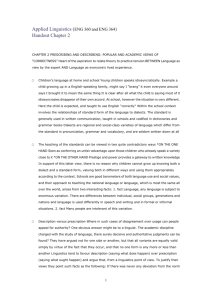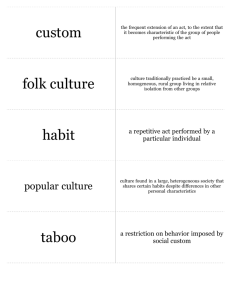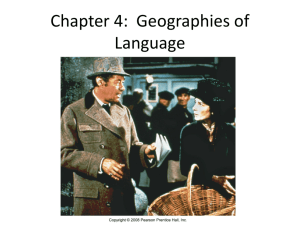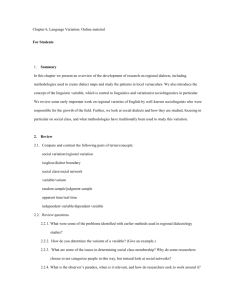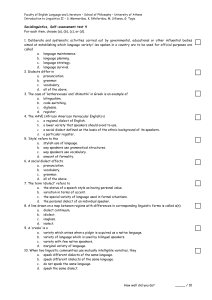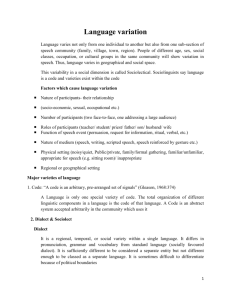isoglosses and dialect boundaries
advertisement
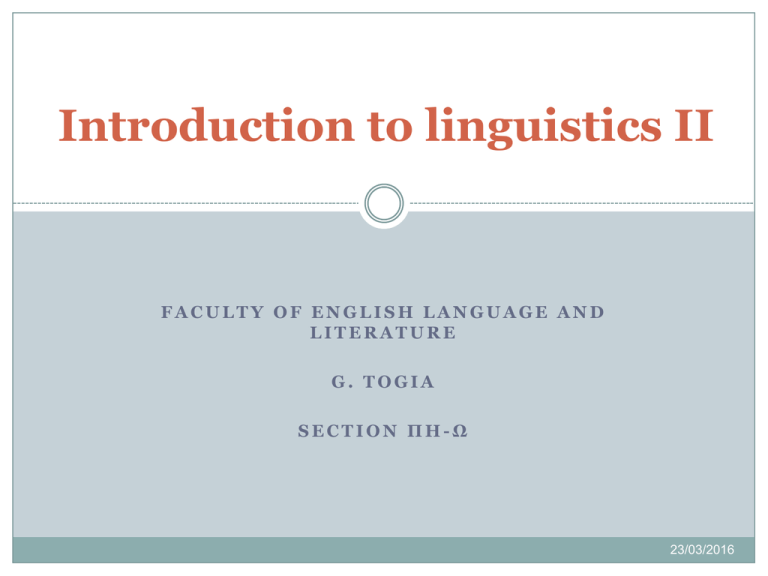
Introduction to linguistics II FACULTY OF ENGLISH LANGUAGE AND LITERATURE G. TOGIA SECTION ΠΗ-Ω 23/03/2016 Today’s topics 2 Language and Regional Variation: The standard language. Accent and dialect. Regional dialects. Isoglosses and dialect boundaries. The dialect continuum. Bilingualism and diglossia. Language planning. Pidgins and Creoles. You can study these topics in: George Yule: Chapter 18. Language and regional variation THE STANDARD LANGUAGE Course title: Introduction to Linguistics II The standard language 4 It is an idealised variety, but exists for most people as the version that is accepted as the official language of their community or country. Where is the SL found? 5 In printed books and newspapers. Used in mass media. Taught at most schools. Taught as a second or foreign language. Examples 6 1. We’re not coming (Standard English dialect) 2. We ain’t coming (non-standard English dialect) Exercise 1 Language and regional variation ACCENT AND DIALECT Course title: Introduction to Linguistics II Accent 8 It refers to the description of aspects of pronunciation that identify where an individual speaker is from, regionally or socially. We all speak with an accent. Dialect 9 It refers to features of grammar and vocabulary as well as aspects of pronunciation. None of the varieties of a language is ‘better’ than any other. Some varieties become more prestigious. Examples of accents and dialects of the UK: http://www.bl.uk/learning/langlit/sounds/index.html http://web.ku.edu/~idea/ http://www.ling.ed.ac.uk/research/gsound Examples of English dialects 10 Some English dialects: Received Pronunciation Cockney (East London) East Anglian (Norfolk, Suffolk and North Essex) Black British English Geordie (Newcastle upon Tyne) Scouse (Merseyside) Mancunian-Salfordian (Manchester & Salford) Etc. Examples: accent 11 The pronunciation of car and year in British and American accents (variation in /r/). The pronunciation of beautiful south and north of London (variation in /ju/ and /u:/ respectively). The pronunciation of but and bus in the south and the north of England (variation of /a/ and /u/ respectively). Examples: dialect 12 The dialectal variation between Have you got the time? in British English vs. Do you have the time? in American English. The dialectal variation between lift (British English) and elevator (American English). Exercises 2-5 Language and regional variation REGIONAL DIALECTS Course title: Introduction to Linguistics II Dialectology 14 Dialectology is the study of dialects. Dialectologists identify and describe those differences in grammar, vocabulary and pronunciation that define different dialects. A criterion for distinguishing between a dialect and a language is mutual intelligibility. Dialectology: some issues 15 However, mutual intelligibility is not always an accurate criterion. Consider: Norwegians claim that they can understand Swedish (different languages). Cantonese speakers cannot understand Mandarin speakers (dialects of Chinese). Serbo-Croatian was spoken in former Yugoslavia. Now Serbian, Croatians and Bosnians claim that they speak different languages. Dialect surveys 16 There are different regional dialects. Investigation of regional dialects involves: Identification of consistent features of speech in one geographical area compared to another. Identification of acceptable informants. Language and regional variation ISOGLOSSES AND DIALECT BOUNDARIES Course title: Introduction to Linguistics II Dialect atlases 18 They are maps that display the geographical distribution of different dialects. Isoglosses: definition 19 A term used for a line drawn on a dialect map which marks off an area which uses a particular variant from another neighbouring area which uses a different variant. The term applies to phonological, grammatical and lexical boundaries. e.g. the use of paper bag in Northern dialect of Midwest America vs. paper sack in Midland dialect of Midwest America. Dialect boundary 20 When a number of isoglosses come together a more solid line can be drawn, which indicates a dialect boundary. E.g. pail in the north and bucket in the south of Midwest America. The [u] vs. [ʌ] isogloss in England (based on Trudgill and Chambers 1980: 128) 21 Greek dialects 22 Language and regional variation THE DIALECT CONTINUUM Course title: Introduction to Linguistics II Dialect continuum 24 At most dialect boundary areas one dialect or language variety merges with another. Regional variation is better viewed as a dialect continuum rather than having sharp breaks from one region to the next. Bidialectal – bilingual 25 Bidialectal: when people speak two dialects. Bilingual: when people speak two distinct languages. Language and regional variation BILINGUALISM AND DIGLOSSIA Course title: Introduction to Linguistics II Bilingualism 1 27 In many countries regional variation is not simply a matter of two (or more) dialects of a single language, but can involve two (or more) quite distinct and different languages. E.g. Canada is an officially bilingual country. Bilingualism 2 28 When referring to an individual bilingualism is the result of two parents who speak different languages. Diglossia: definition 29 In diglossia there is typically: a “low” variety (spoken language) acquired locally and used for everyday affairs and a “high” variety (written language) learned in school and used for important and institutional matters. Diglossia: examples 30 In Arab speaking countries: the high variety (Classical Arabic) is used in formal lectures, serious political events, religious discussions, etc. The low variety is the local Egyptian Arabic, Tunisian Arabic, Lebanese Arabic, etc. The use of katharevousa and dimotiki in Greece before 1976. Exercise 6 Language and regional variation LANGUAGE PLANNING Course title: Introduction to Linguistics II Language planning: definition 32 It concerns planning which variety or varieties of the languages spoken in a particular country are to be used for official business. Language planning: steps 33 The process of establishing a national official language involves five interrelated steps: Selection: choosing the variety (to be developed). Codification: standardising its structural or linguistic features (dictionaries, grammar books to be written, etc.). Elaboration: extending its functions for use in other domains (all aspects of social life, literature, etc.). Implementation: promoting the use of the standard variety. Acceptance: accepting the variety as the national language by the majority of the population. Language and regional variation PIDGINS AND CREOLES Course title: Introduction to Linguistics II Pidgin: definition 35 A pidgin is: a variety of a language (e.g. English) that developed for some practical purpose, such as trading, among groups of people who had a lot of contact, but who did not know each other’s languages. Pidgin: example 36 Tok Pisin, spoken in Papua New Guinea. Lexifier language (main source of words): English tu buk (two books) di gyal place (the girl’s place) bilong (your) buk bilong yu (your book) Characteristics of pidgins 37 Simple grammatical morphology. Somewhat limited vocabulary. Plural suffix –s and the possessive form (’s) on nouns are rare. Use of functional instead of inflectional morphemes: E.g. use of bilong instead of changing you to your. Syntax: quite unlike the syntax of the languages from which terms were borrowed and modified. Creole 38 When a pidgin develops beyond its role as a trade or contact language and becomes the first language of a social community it is described as a creole. Tok Pisin is now a creole. French creoles in Haiti. English creoles in Jamaica and Sierra Leone. Post-creole continuum 39 Creolisation: development from a pidgin to a creole. Decreolisation: where education and greater social prestige are associated with a ‘higher’ variety (e.g. British English in Jamaica), a number of speakers will tend to use fewer creole forms and structures. Post-creole continuum: This leads to a continuum of varieties with the external standard model at one extreme and a basic variety with local creole features at the other. Example 40 This situation exists in Jamaica: People from upper and middle class speak the English variety. People from lower middle class and working class speak the intermediate varieties. People from the lower working class and farmers speak the creole variety. Exercise 7 Summary 1 41 The standard language: an idealised variety, but exists for most people as the version that is accepted as the official language of their community or country. Accent: it refers to the description of aspects of pronunciation that identify where an individual speaker is from, regionally or socially. Dialect: it refers to features of grammar and vocabulary as well as aspects of pronunciation. Regional dialects: a criterion for distinguishing between a dialect and a language is mutual intelligibility. Summary 2 42 Isogloss: it is a term used for a line drawn on a dialect map which marks off an area which uses a particular variant from another neighbouring area which uses a different variant. Dialect boundaries: when a number of isoglosses come together a more solid line can be drawn, which indicates a dialect boundary. The dialect continuum: regional variation is better viewed as a dialect continuum rather than having sharp breaks from one region to the next. Summary 3 43 Bilingualism: when two (or more) distinct and different languages are spoken in one country. Bilingualism is also the result of having two parents who speak different languages. Diglossia: in diglossia there is typically a “low” variety acquired locally and used for everyday affairs and a “high” variety learned in school and used for important and institutional matters. Language planning: concerns planning which variety or varieties of the languages spoken in a particular country are to be used for official business. Summary 4 44 Pidgin: a variety of a language (e.g. English) that developed for some practical purpose, such as trading, among groups of people who had a lot of contact, but who did not know each other’s languages. Creole: when a pidgin develops beyond its role as a trade or contact language and becomes the first language of a social community it is described as a creole. Next week... 45 Language and Social Variation: Sociolinguistics. Social dialects. Education and occupation. Social markers. Speech style and style-shifting. Prestige. Speech accommodation. Register and jargon. Slang. Social barriers. Vernacular language.




